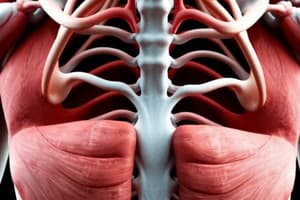Podcast
Questions and Answers
Which muscle is primarily responsible for shoulder movement?
Which muscle is primarily responsible for shoulder movement?
- Deltoid
- Latissimus dorsi
- Trapezius (correct)
- Pectoralis major
What type of muscle is primarily involved in voluntary movement?
What type of muscle is primarily involved in voluntary movement?
- Cardiac muscle
- Smooth muscle
- Fibrous muscle
- Skeletal muscle (correct)
What function do superficial muscles NOT primarily serve?
What function do superficial muscles NOT primarily serve?
- Generate heat
- Facilitate movement
- Support posture
- Regulate blood pressure (correct)
Which muscle is located in the front of the upper arm and is responsible for elbow flexion?
Which muscle is located in the front of the upper arm and is responsible for elbow flexion?
What type of muscle is found in the walls of hollow organs?
What type of muscle is found in the walls of hollow organs?
Which of the following muscles is involved in arm abduction?
Which of the following muscles is involved in arm abduction?
Which muscle supports trunk flexion and stability?
Which muscle supports trunk flexion and stability?
Which is a characteristic of cardiac muscle?
Which is a characteristic of cardiac muscle?
What is NOT a function of the superficial layer muscles?
What is NOT a function of the superficial layer muscles?
Which superficial muscle is responsible for aiding in shoulder adduction and extension?
Which superficial muscle is responsible for aiding in shoulder adduction and extension?
Flashcards are hidden until you start studying
Study Notes
Anatomy Of Superficial Muscles
- Located just beneath the skin (subcutaneous tissue).
- Primarily composed of:
- Skeletal muscles: Voluntary muscles that facilitate movement.
- Fascia: Connective tissue that surrounds muscles, providing support and structure.
- Major superficial muscle groups include:
- Trapezius: Upper back and neck; responsible for shoulder movement.
- Latissimus dorsi: Lower back; aids in shoulder adduction and extension.
- Pectoralis major: Chest; involved in arm flexion, adduction, and rotation.
- Deltoid: Shoulder; enables arm abduction.
- Biceps brachii: Front of the upper arm; flexes the elbow and supinates the forearm.
- Rectus abdominis: Abdomen; supports trunk flexion and stability.
Muscle Types In The Superficial Layer
-
Skeletal Muscle:
- Striated appearance.
- Under voluntary control.
- Multi-nucleated fibers.
- Responsible for body movement and posture.
-
Smooth Muscle:
- Non-striated and involuntary.
- Found in the walls of hollow organs (not typically classified within superficial muscles, but occasionally present in fascia).
-
Cardiac Muscle:
- Striated but involuntary.
- Found only in the heart; not a component of the superficial layer.
Function Of Superficial Layer Muscles
- Movement: Facilitate voluntary movement of limbs and body.
- Posture: Help maintain body posture and alignment.
- Stability: Provide stability to joints and assist in balance.
- Protection: Shield underlying structures (organs, bones) from injury.
- Heat Production: Generate heat through muscular contractions, aiding in thermoregulation.
- Facial Expressions: Control facial muscles for expressions and communication.
Anatomy Of Superficial Muscles
- Superficial muscles are situated just beneath the skin, within subcutaneous tissue.
- Comprised mainly of skeletal muscles, which are under voluntary control and facilitate body movement.
- Fascia is a connective tissue that encases muscles, offering structural support.
- Major superficial muscle groups include:
- Trapezius: Located in the upper back and neck, responsible for shoulder movement.
- Latissimus dorsi: Found in the lower back, aids in shoulder adduction and extension.
- Pectoralis major: Located in the chest, involved in arm flexion, adduction, and rotation.
- Deltoid: Situated at the shoulder, enables arm abduction.
- Biceps brachii: Found at the front of the upper arm, it flexes the elbow and supinates the forearm.
- Rectus abdominis: Located in the abdomen, supports trunk flexion and stability.
Muscle Types In The Superficial Layer
- Skeletal Muscle:
- Exhibits a striated appearance and is responsible for voluntary movement.
- Characterized by multi-nucleated fibers, contributing to strength and mobility.
- Smooth Muscle:
- Non-striated and operates involuntarily, found in the walls of hollow organs.
- Not typically classified within superficial muscles, but can occasionally be present in fascia.
- Cardiac Muscle:
- Exhibits a striated appearance yet is involuntary, located exclusively in the heart.
- Not part of the superficial muscle layer.
Function Of Superficial Layer Muscles
- Movement: Enable voluntary movements of limbs and the body.
- Posture: Aid in maintaining body posture and alignment.
- Stability: Provide joint stability and assist in maintaining balance.
- Protection: Serve to shield underlying structures, such as organs and bones, from potential injury.
- Heat Production: Generate heat through muscle contractions, aiding in thermoregulation.
- Facial Expressions: Control facial muscles, facilitating expressions and communication.
Studying That Suits You
Use AI to generate personalized quizzes and flashcards to suit your learning preferences.




